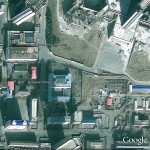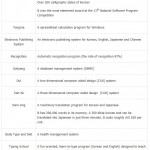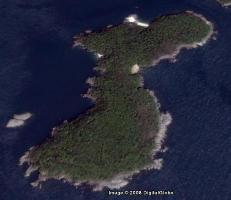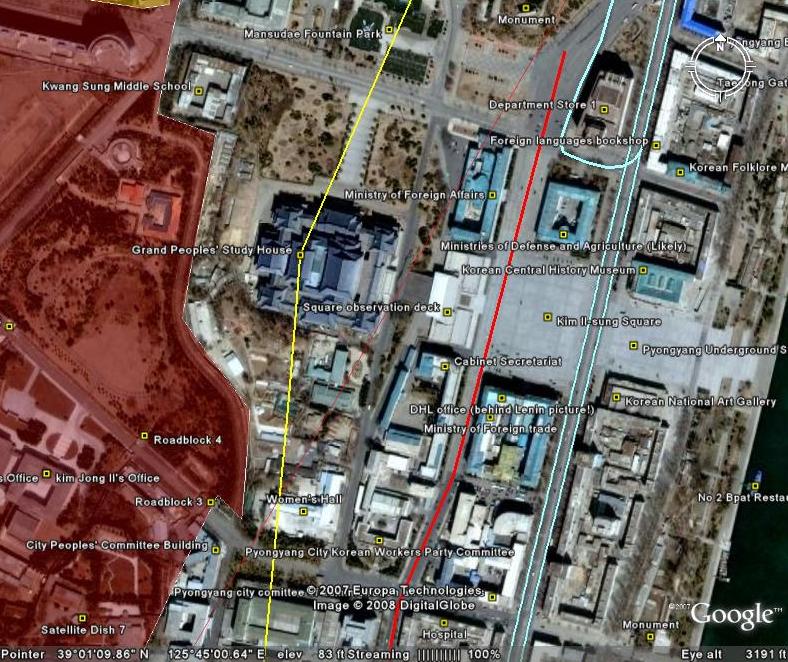Archive for the ‘Pyongyang International Information Center of New Techn’ Category
Monday, December 6th, 2010

Pictured Above (Google Earth): Pyongyang Information Center and Annex
* AKA Pyongyang Informatics Center
Choi Sung, Professor of computer science at Namseoul University, writes in the IT Times:
I have been writing about North Korea’s IT industry since the start of this year. In this installment, I would like to introduce North Korea’s major information and communications institution. If the Choson Computer Centre (KCC) is called the centerpiece of North Korea’s IT R&D, Pyongyang Information Centre (PIC) is the mecca of their software development. The PIC, founded on July 15, 1986, was jointly funded by the United Nations Development Programme (UNDP) and Jochongnyeon (the pro-Pyongyang federation of Korean residents in Japan). It is situated in Kyong-Heung dong near the Botong River in Pyongyang.
The PIC was created as the Pyongyang Program Development Company and changed its name to Pyongyang Electronic Calculator Operator in October of 1988 and then again to Pyongyang Information Centre (PIC) in July of 1991. As of now, the best and the brightest of North Korea’s IT talent is developing various kinds of programs and devices at the PIC: nearly 300 IT professionals, who graduated from the North’s most prestigious universities such as Kim Il-sung University, Kim Chaek University of Technology and Pyongyang University of Science and Technology (PUST), are on the payroll of the PIC.
On the overseas front, the PIC has its branches in China, Japan and Singapore, where PIC IT experts are working on software development, and has teamed up with foreign companies to jointly develop software programs and expedite technology transfers. The PIC, North Korea’s major software developer, has been at the vanguard of these following areas: language information processing, machinery translation, document editing, global IMEs (Input Message Editor), computer-aided design (CAD), networks, database systems, fonts, multimedia, dynamic images, etc. For instance, the PIC’s database development taskforce consists of about 40 IT experts, who are all working on the development of information management systems for production lines, companies and other institutions. The PIC’s publishing group has been engaged in various R&D projects from the development of Chang-Deok, a PC word processor, to DTP (desk top publishing) systems for Mac computers. Last but not least, the PIC’s application software group is keen on CAD, virtual reality and the development of project management devices. The PIC has been developing a plethora of software products: embedded software, CAD, image processing, Korean-language information processing and systems, network management systems, multimedia dynamic images, etc. The PIC’s 3D CAD has been widely employed by North Korean and foreign architectural design companies and more sophisticated versions of it are coming out. What’s more, the PIC is ramping up its joint R&D efforts with overseas IT developers with a focus on the development of diverse image processing programs. Korean-language information processing and systems are about developing the technologies for character recognition, voice recognition, natural language processing and primary retrieval while the development of network management systems includes fire walls, security solutions, encryption, e-commerce, IC cards, instant messenger programs, mobile game programs, etc. They are also working on the development of multimedia and dynamic images: technologies for producing 3D materials, 2D cartoon production and the technology for adding accompaniments to images are being developed. The PIC’s font development team has developed 300 Korean fonts and a myriad of calligraphic styles for imported mobile phones and dot fonts for PDAs.

The PIC has thus far scaled up its IT exchanges with overseas information and technology companies as well as R&D institutions. A case in point is the North-South joint venture, HANA Program Center, which is located in Dandong-si in Liaoning, China and was jointly invested in May of 2001 by the PIC and North-South HANA Biz, a subsidiary of South Korea’s Dasan Network. Another showpiece of the PIC’s effort for joint R&D is the software development for fonts and Chinese character recognition in collaboration with Soltworks (an e-publishing software developer). On top of that, the PIC’s IT exchanges with overseas institutions have been on the rise.
As such, inter-Korean cooperation projects will serve as the driving force behind the PIC’s IT exchanges with South Korea. To that end, non-military sanctions imposed on Pyongyang should be eased, such as the Wassenaar Arrangement (a multilateral export control regime (MECR) with 40 participating states) should be eased to move US – North Korea relations forward and the US’s EAR (Export Administration Regulation) on the North should be scaled back. Above all, IT-initiated unification of the two Koreas should be preceded by pragmatic dialogues with the North and North Korea’s efforts for reaching out to other nations. As of now, the North needs to draw up a future blueprint to embark on phased cooperation with the S. Korean government and companies in a bid to open its doors to the international community.
UPDATE from a reader who has spent some time there:
[T]hey are an interesting institution that not everyone has a chance to see from the inside. What was interesting is that they really work on software for foreign markets (i.e. mobile software for well known international cell network providers). In addition to that they have an impressive library of books on all topics of software development which was up-to-date at the time I visited.
In contrast to the other institutions they immediately showed commercial accomplishments instead of where the leaders have walked. Employees have access to a gym too. A place out of place in Pyongyang. What I found interesting in the article is that the mentioned developments match some of those the KCC presents in their building. The PIC made much more an impression of a service unit for foreign customers than for the country itself. However, they are training hardware specialists for the infrastructure there.
Read the full story here:
North Korea’s IT Application Software Development Center – Pyongyang Information Centre (PIC)
IT Times
Choi Sung
12/6/2010
Posted in Chongryun, Computing/IT, Japan, Pyongyang International Information Center of New Techn, UN, UNDP | Comments Closed
Thursday, August 14th, 2008
The most authoritative map of North Korea on Google Earth
Download it here
 This map covers North Korea’s agriculture, aviation, cultural locations, markets, manufacturing facilities, railroad, energy infrastructure, politics, sports venues, military establishments, religious facilities, leisure destinations, and national parks. It is continually expanding and undergoing revisions. This is the eleventh version.
This map covers North Korea’s agriculture, aviation, cultural locations, markets, manufacturing facilities, railroad, energy infrastructure, politics, sports venues, military establishments, religious facilities, leisure destinations, and national parks. It is continually expanding and undergoing revisions. This is the eleventh version.
Additions include: Mt. Paegun’s Ryonghung Temple and resort homes, Pyongyang’s Chongryu Restaurant, Swiss Development Agency (former UNDP office), Iranian Embassy, White Tiger Art Studio, KITC Store, Kumgangsan Store, Pyongyang Fried Chicken Restaurant, Kilju’s Pulp Factory (Paper), Kim Chaek Steel Mill, Chongjin Munitions Factory, Poogin Coal Mine, Ryongwun-ri cooperative farm, Thonggun Pavilion (Uiju), Chinju Temple (Yongbyon), Kim il Sung Revolutionary Museum (Pyongsong), Hamhung Zoo, Rajin electrified perimeter fence, Pyongsong market (North Korea’s largest), Sakju Recreation Center, Hoeryong Maternity Hospital, Sariwon Suwon reservoir (alleged site of US massacre), Sinpyong Resting Place, 700 Ridges Pavilion, Academy of Science, Hamhung Museum of the Revolutionary Activities of Comrade Kim Il Sung, South Hamgyong House of Culture, Hamhung Royal Villa, Pork Chop Hill, and Pyongyang’s Olympic torch route. Additional thanks go to Martyn Williams for expanding the electricity grid, particularly in Samjiyon, and various others who have contributed time improving this project since its launch.
Disclaimer: I cannot vouch for the authenticity of many locations since I have not seen or been to them, but great efforts have been made to check for authenticity. These efforts include pouring over books, maps, conducting interviews, and keeping up with other peoples’ discoveries. In many cases, I have posted sources, though not for all. This is a thorough compilation of lots of material, but I will leave it up to the reader to make up their own minds as to what they see. I cannot catch everything and I welcome contributions. Additionally, this file is getting large and may take some time to load.
Posted in Advertising, Agriculture, Architecture, Art, Automobiles, Aviation, Banking, Biotech, Cell phones, Central Broadcasting Station, Coal, Committee for Cultural Relations with Foreign Countries, Communications, Computing/IT, Construction, Dams/hydro, Demographics, Domestic publication, Education, Electricity, Energy, Environmental protection, Film, Finance, Food, Football (soccer), Foreign direct investment, Forestry, Gambling, Gasoline, General markets (FMR: Farmers Market), Golf, Google Earth, Health care, Hoteling, Hwanggumphyong and Wihwado Economic Zones (Sinuiju), Intranet, Joint Ventures, Kaesong Industrial Complex (KIC), Kim Il Sung University, Korean Buddhist Association, Labor conditions/wages, Leisure, Library, Light Industry, Lumber, Mansu Art Studio, Manufacturing, Mass games, Maternity Hospital, Military, Mining/Minerals, Ministry of foreign Affairs, Ministry of Foreign Trade, Ministry of People’s Armed Forces, Ministry of Post and Telecommunications, Ministry of Public Health, Mt. Kumgang Tourist Special Zone, Musan Mine, Nuclear, Oil, Phoenix Commerical Ventures, Pyongyang Embroidery Institute, Pyongyang Film Studio, Pyongyang International Information Center of New Techn, Pyongyang International Trade Fair, Pyongyang Metro, Pyongyang University of Medicine, Radio, Railways, Rason Economic and Trade Zone (Rajin-Sonbong), Real estate, Religion, Restaurants, Sea shipping, Sports, Steel, Supreme Peoples Assembly, Tourism, Transportation, Wind | 6 Comments »
Friday, December 14th, 2007
The most authoritative map of North Korea on Google Earth
North Korea Uncovered v.7
Download it here
 This map covers North Korea’s agriculture, aviation, cultural locations, manufacturing facilities, railroad, energy infrastructure, politics, sports venues, military establishments, religious facilities, leisure destinations, and national parks. It is continually expanding and undergoing revisions. This is the sixth version.
This map covers North Korea’s agriculture, aviation, cultural locations, manufacturing facilities, railroad, energy infrastructure, politics, sports venues, military establishments, religious facilities, leisure destinations, and national parks. It is continually expanding and undergoing revisions. This is the sixth version.
Additions to the latest version of “North Korea Uncovered” include: A Korean War folder featuring overlays of US attacks on the Sui Ho Dam, Yalu Bridge, and Nakwon Munitians Plant (before/after), plus other locations such as the Hoeryong Revolutionary Site, Ponghwa Revolutionary Site, Taechon reactor (overlay), Pyongyang Railway Museum, Kwangmyong Salt Works, Woljong Temple, Sansong Revolutionary Site, Jongbansan Fort and park, Jangsan Cape, Yongbyon House of Culture, Chongsokjong, Lake Yonpung, Nortern Limit Line (NLL), Sinuiju Old Fort Walls, Pyongyang open air market, and confirmed Pyongyang Intranet nodes.
Disclaimer: I cannot vouch for the authenticity of many locations since I have not seen or been to them, but great efforts have been made to check for authenticity. These efforts include pouring over books, maps, conducting interviews, and keeping up with other peoples’ discoveries. In many cases, I have posted sources, though not for all. This is a thorough compilation of lots of material, but I will leave it up to the reader to make up their own minds as to what they see. I cannot catch everything and I welcome contributions.
Posted in Architecture, Art, Automobiles, Aviation, Cell phones, Civil society, Coal, Committee for Cultural Relations with Foreign Countries, Communications, Computing/IT, Construction, Dams/hydro, Department Store No. 1, Education, Electricity, Email, Energy, Film, Finance, Football (soccer), Forestry, Gambling, General markets (FMR: Farmers Market), Golf, Google Earth, Hana Electronics Company, Health care, Hoteling, Hwanggumphyong and Wihwado Economic Zones (Sinuiju), Hyesan Youth Cooper Mine, International Aid, Internet, Intranet, Juche, Kaesong Industrial Complex (KIC), Kim Chaek University of Technology, Kim Il Sung University, Korea Computer Center (KCC), Korean Buddhist Association, Korean People's Army, Light Industry, Lumber, Mansudae creative Company (art studio), Manufacturing, Mass games, Maternity Hospital, Military, Mining/Minerals, Ministry of foreign Affairs, Ministry of Foreign Trade, Mt. Kumgang Tourist Special Zone, Musan Mine, Nuclear, Pyongyang Embroidery Institute, Pyongyang Film Studio, Pyongyang Informatics Center (PIC), Pyongyang International Information Center of New Techn, Pyongyang International Trade Fair, Pyongyang Metro, Pyongyang University of Medicine, Radio, Railways, Rason Economic and Trade Zone (Rajin-Sonbong), Real estate, Religion, Restaurants, Sea shipping, Sports, Television, Transportation, Wind | Comments Closed
Sunday, November 11th, 2007
The most authoritative map of North Korea on Google Earth
North Korea Uncovered: Version 6
Download it here
 This map covers North Korea’s agriculture, aviation, cultural locations, manufacturing facilities, railroad, energy infrastructure, politics, sports venues, military establishments, religious facilities, leisure destinations, and national parks. It is continually expanding and undergoing revisions. This is the sixth version.
This map covers North Korea’s agriculture, aviation, cultural locations, manufacturing facilities, railroad, energy infrastructure, politics, sports venues, military establishments, religious facilities, leisure destinations, and national parks. It is continually expanding and undergoing revisions. This is the sixth version.
Additions to the newest version of North Korea Uncovered include: Alleged Syrian nuclear site (before and after bombing), Majon beach resort, electricity grid expansion, Runga Island in Pyongyang, Mt. Ryongak, Yongbyon historical fort walls, Suyang Fort walls and waterfall in Haeju, Kaechon-Lake Taesong water project, Paekma-Cholsan waterway, Yachts (3), and Hyesan Youth Copper Mine.
Disclaimer: I cannot vouch for the authenticity of many locations since I have not seen or been to them, but great efforts have been made to check for authenticity. These efforts include pouring over books, maps, conducting interviews, and keeping up with other peoples’ discoveries. In many cases, I have posted sources, though not for all. This is a thorough compilation of lots of material, but I will leave it up to the reader to make up their own minds as to what they see. I cannot catch everything and I welcome contributions.
Posted in Advertising, Agriculture, Architecture, Automobiles, Aviation, Banking, Black markets, Committee for Cultural Relations with Foreign Countries, Communications, Computing/IT, Dams/hydro, Department Store No. 1, Economic reform, Education, Electricity, Energy, Environmental protection, Film, Finance, Fiscal & monetary policy, Football (soccer), Forestry, Gambling, Gasoline, General markets (FMR: Farmers Market), Golf, Google Earth, Hana Electronics Company, Health care, Hoteling, Hwanggumphyong and Wihwado Economic Zones (Sinuiju), Hyesan Youth Cooper Mine, Kaesong Industrial Complex (KIC), Kim Il Sung University, Korea Computer Center (KCC), Library, Light Industry, Mansudae creative Company (art studio), Manufacturing, Mass games, Maternity Hospital, Military, Mining/Minerals, Ministry of Culture, Ministry of Foreign Trade, Mt. Kumgang Tourist Special Zone, Musan Mine, Music, Nuclear, Pyongyang Embroidery Institute, Pyongyang Film Studio, Pyongyang Informatics Center (PIC), Pyongyang International Information Center of New Techn, Pyongyang International Trade Fair, Pyongyang Metro, Railways, Rason Economic and Trade Zone (Rajin-Sonbong), Real estate, Religion, Restaurants, Sea shipping, Special Economic Zones (Established before 2013), Sports, Steel, Supreme Peoples Assembly, Television, Tourism, Transportation, Water, Wind | Comments Closed
Thursday, November 23rd, 2006
Yonhap
11/23/2006
North Korea’s top energy policy is to develop wind energy in a three-stage project planned out to 2020, the country’s officials said in an Asian conference earlier this month.
They claimed they have turned to building hydraulic power stations after the construction of a light-water reactor promised by the international community was suspended.
North Korea is a participant in the Asian Energy Security Workshop sponsored by the San Francisco-based Nautilus Institute and Tsinghua University in China. This year’s meeting was in Beijing on Nov. 5-7, and papers from the conference were recently posted last week on the Nautilus Web site.
South Korea, Russia, China, Japan and Mongolia were also participants.
The paper submitted by the North Korean delegation said building up the wind energy sector is “considered a top priority for policymakers, technicians and managers” in Pyongyang.
North Korea would first construct a prototype wind farm with a 10-megawatt capacity by the year 2010, then build three main wind farms with a capacity of 100 megawatts by 2015, the paper said.
In the third stage ending in 2020, onshore and offshore wind farms would be built throughout the country, it said.
North Korea has already received outside assistance for its wind energy projects, including from Denmark, which provided wind turbines that were installed along the country’s west coast in 1986. The Nautilus Institute funded the installation of a standalone wind energy system in 1998.
The paper cited fund shortages and technological barriers in pursuing the policy, but said “these problems will be gradually solved through the correct policy of the DPRK” and cooperation with the international community.
Ri Yong-ho, an official at the Pyongyang International Information Center of New Technology and Economy, said his country turned to hydraulic power stations after work on the light-water reactor was suspended.
Under the 1994 Geneva Agreed Framework, the North was to receive two reactors financed by the international community in exchange for freezing its nuclear activities. The agreement fell through after Pyongyang was accused of hiding a secret nuclear weapons program.
“To cope with this situation, the DPRK began to increase government investment in the construction of hydraulic power stations,” Ri said in his presentation.
“Our future direction for securing energy is the technological upgrading of existing thermal power plants to increase energy conversion efficiency, further construction of hydraulic power stations to raise its proportion, and taking positive measures to develop and use renewable energy, including wind power,” he said.
But no new plants are being built for the time being, Ri said.
The official said Pyongyang was also trying organic matter energy, particularly methane gas.
“For this purpose, professional research institutions for producing methane gas were organized and set to work to continuously renew and develop the technology of gasification and introduce it to productive sites,” he said.
Posted in Dams/hydro, Energy, Nautilus Institute, Pyongyang International Information Center of New Techn | Comments Closed


